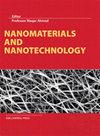使用Murraya paniculata(L.)jack leaves生产的抗菌、抗氧化和血管生成生物活性银纳米颗粒
IF 3.3
3区 材料科学
Q2 MATERIALS SCIENCE, MULTIDISCIPLINARY
引用次数: 14
摘要
Murraya paniculata(MP)可以用作还原剂,使用简单的程序生产银纳米颗粒(AgNP)。AgNPs具有形态和化学特性、抗氧化活性和细胞毒性。源自MP的AgNPs的形态显示出面心立方结构、平均粒径为23nm的球形。使用UV-vis光谱仪在438nm处显示AgNPs的化学结构的特征峰。通过分析AgNPs在红外辐射下的振动状态,证实了AgNPs的形成;AgNPs的典型峰被识别为:分别在3429 cm−1(O-H伸缩、H-键合醇、酚基)、2923 cm−1、1626 cm−1。MP产生的AgNPs具有抗氧化活性和细胞毒性。它们对蜡样芽孢杆菌表现出最高的敏感性。通过对体外人内皮静脉细胞的划痕试验测定,由MP产生的生物合成AgNPs的细胞毒性显示出剂量依赖性活性。这些浓度为15.625μg/mL的AgNPs刺激内皮细胞(EC)的增殖和迁移,显示出血管生成活性。本文章由计算机程序翻译,如有差异,请以英文原文为准。
Antimicrobial, antioxidant, and angiogenic bioactive silver nanoparticles produced using Murraya paniculata (L.) jack leaves
Murraya paniculata (MP) can be used as a reducing agent to produce silver nanoparticles (AgNPs) using a simple procedure. AgNPs are characterized in morphological and chemical properties, antioxidant activity, and cytotoxicity. The morphology of AgNPs derived from MP shows a face-centered cubic structure, spherical shape with an average particle size of 23 nm. The chemical structure shows characteristic peaks of AgNPs using UV-vis spectrometer at 438 nm. The formation of AgNPs is confirmed by analyzing their vibrational states under infrared radiation; typical peaks of AgNPs are recognized: at 3429 cm−1 (O-H stretch, H-bonded alcohols, phenols groups), 2923 cm−1 (C-H stretch alkanes), 1626 cm−1 (N-H bend 1° amines), 1583 cm−1 (C-C stretch in ring aromatic), 1039 cm−1 (C-N stretch aliphatic amines), 728 cm−1 (C-Cl stretch alkyl halides), and 589 cm−1 (C-Br stretch alkyl halides), respectively. AgNPs produced from MP show antioxidant activity and cytotoxicity. They show the highest sensitivity toward Bacillus cereus. Cytotoxicity of biosynthesized AgNPs, determined by scratch wound assay on in vitro human endothelial vein cell, created from MP showed dose-dependent activity. These AgNPs, at a concentration of 15.625 μg/mL, stimulate the proliferation and migration of endothelial cells (EC) showing an angiogenic activity.
求助全文
通过发布文献求助,成功后即可免费获取论文全文。
去求助
来源期刊

Nanomaterials and Nanotechnology
NANOSCIENCE & NANOTECHNOLOGY-MATERIALS SCIENCE, MULTIDISCIPLINARY
CiteScore
7.20
自引率
21.60%
发文量
13
审稿时长
15 weeks
期刊介绍:
Nanomaterials and Nanotechnology is a JCR ranked, peer-reviewed open access journal addressed to a cross-disciplinary readership including scientists, researchers and professionals in both academia and industry with an interest in nanoscience and nanotechnology. The scope comprises (but is not limited to) the fundamental aspects and applications of nanoscience and nanotechnology
 求助内容:
求助内容: 应助结果提醒方式:
应助结果提醒方式:


